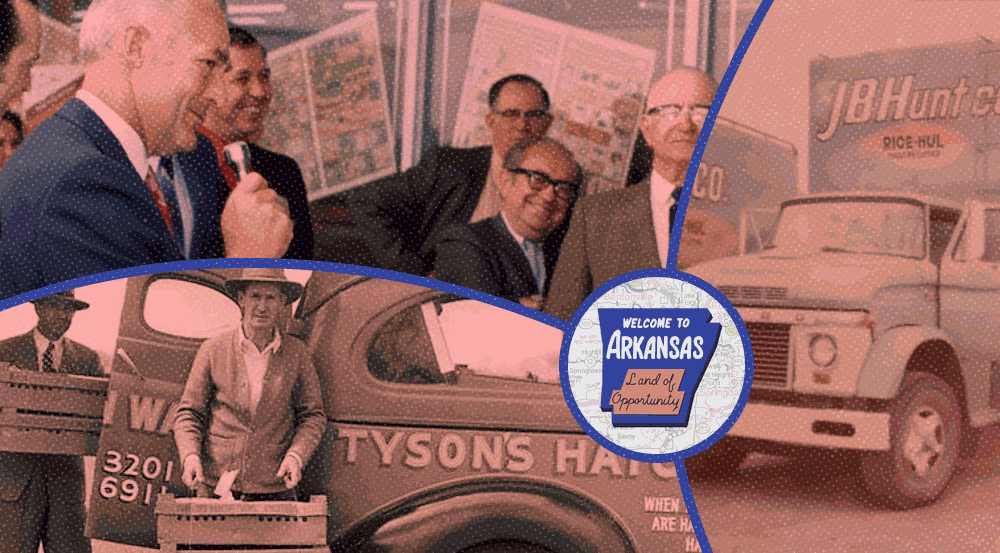The Land of Opportunity: The Beginnings of Northwest Arkansas’ Supply Chain Cluster

April 5, 2021 | By Ron Gordon
From the Supply Chain Management Research Center at the University of Arkansas
In 1953, Arkansas lawmakers rechristened the state “The Land of Opportunity.”
The aspirational moniker was intended to signal that the former Bear State, Wonder State and Toothpick State (a reference to Jim Bowie’s famous knife) was ready to put its rural traditions behind it and enter a new age of economic development. While the nickname proved to be somewhat wishful thinking for parts of the state, Northwest Arkansas lived up to the lofty title.
Between 1930 and 1975, the seeds were sown for Northwest Arkansas to emerge as a global business powerhouse. By 1975, the region also had many of the makings of a supply chain cluster: a concentrated set of supply chain-related business activities.
In anticipation of the SCMRC’s upcoming Trends Conference - which will explore current developments in Northwest Arkansas’ supply chain cluster - this article examines some of the historical factors that made that supply chain cluster possible.
People
Many elements determine why supply chain clusters develop in some places and not others. Geography, government policy and education all factor into the equation. But it also helps to have a bit of luck - the sort of luck that brings risk-taking visionaries together in the same place at the same time.
In that regard, postwar Northwest Arkansas was luckier than most. It was the adopted home of several entrepreneurs who came to the area seeking opportunity, established future Fortune 500 companies and revolutionized American agriculture, food processing, retail and transportation.
Missourian John W. Tyson brought his family to Springdale in 1931, seeking opportunity in the throes of the Great Depression. He and his son Don’s pioneering vision of a vertically integrated poultry operation laid the foundation for what is today the world’s second-largest marketer and processor of chicken, beef and pork: Tyson Foods.
Though Sam Walton probably didn’t feel lucky when his Newport, Arkansas, landlord refused to renew the lease on his successful Ben Franklin store in 1950, that temporary setback worked out pretty well for both Walton and Northwest Arkansas. The landlord’s decision helped bring Walton to Bentonville, where he established the home base of what eventually became the world’s largest corporation and largest private employer: Walmart.
Johnnie Bryan and Johnelle Hunt had a rough start after establishing their poultry litter company in Stuttgart, Arkansas in 1961. But things turned around for them when they shifted their focus to trucking in 1969 and relocated to Lowell, where they hauled Tyson chickens and eventually made Walmart their biggest customer. J.B. Hunt became the state’s largest trucking company and a big reason why, by 2005, one out of thirteen Arkansans worked in the industry.
Geography
Northwest Arkansas’ hilly terrain proved to be a blessing in disguise for the region. Had the area been flat, it may have been the midcentury home of large cities with limited industrial development (i.e. Little Rock) or large-scale farms (i.e. the Arkansas Delta). Instead, the region’s mountains, small towns and relative lack of economic development offered fertile ground for innovation, an eager workforce and an ideal location for the development of a supply chain hub.
Fully aware of the difficulty of growing crops in the Ozarks, many local small farmers gladly agreed to raise chickens for the Tysons. The Tysons’ willingness to provide chicks, feed and transportation appealed to many farmers. Their offer of preset prices sweetened the deal. Northwest Arkansas farmers witnessed the collapse of the region’s fruit growing operations during the Great Depression, so the Tysons’ contracts seemed a much safer bet than gambling on future market fluctuations (the Ben F. Johnson III book linked above, page 204).
Sam Walton’s business model involved offering low prices and great selection to small-town inhabitants that large discount retailers typically overlooked, so Bentonville (1950 population: 2,942) offered a logical destination for the first Walton’s 5&10. Sparsely populated Northwest Arkansas offered plenty of opportunities for Walton to hone his business model and open new locations, including the first Wal-Mart Discount City store in Rogers (1960 population: 5,700) in 1962 (page 211).
What Northwest Arkansas lacked in population density, it made up for with its prime location. The region is within driving distance of many large cities, making it an ideal home base for J.B. Hunt and - after Walton built his Bentonville distribution center and entered the trucking business in 1970 - Walmart Transportation (page 218).
Government Policy
Government support can make or break a region’s economic development, so it’s unsurprising that Northwest Arkansas’ early growth was aided by state and federal policies. For instance, the $25 billion Federal Highway Act of 1956 created the interstate highway system that eventually allowed Northwest Arkansas to realize its potential as a logistics hub between large cities like Dallas, Oklahoma City, St. Louis, Little Rock and Memphis.
Shortly after John W. Tyson entered the poultry business, federal lawmakers implemented two policies that proved very beneficial to his firm’s growth. The Rural Electrification Act of 1936 helped electrify Northwest Arkansas farms, allowing farmers to power the facilities and equipment needed to efficiently raise chickens. This dovetailed nicely with an explosion in national demand for chicken following the federal government’s decision to exempt the meat from rationing limits during World War II. Consumption of chicken doubled between 1938 and 1943, and many Americans retained their newfound taste for the meat after rationing ended and other options were available (page 69).
Arkansas policymakers’ mid-century rebranding of the state as the “Land of Opportunity” was part of a concerted effort to make it more business-friendly. Their reforms included making Arkansas one of the nation’s first “right to work” states in 1944, establishing the University of Arkansas’ Bureau of Business and Economic Research in 1945 and creating the Arkansas Industrial Development Commission in 1955 (page 110).
Education
Just as government support can facilitate the development of a supply chain cluster, so can the presence of a nearby university. The University of Arkansas was well established by the time John W. Tyson moved to Springdale, offering colleges of both agriculture and business administration. As Tyson Foods, Walmart and J.B. Hunt grew and needed new managers, the U of A offered capable graduates to fill those positions.
The mutually beneficial relationship with local business facilitated the university’s growth, boosting its job placement rates and providing generous gifts like the 1973 donation from Sam and Helen Walton that established the Walmart Faculty Fund in Marketing (a precursor to the Walton family’s historic $50 million 1998 gift that fueled unprecedented growth for the rechristened Sam M. Walton College of Business). The relationship with local firms also allowed university professors to access invaluable datasets and help solve real-world problems. For example, U of A agriculture professors helped the Tysons breed chickens that reached maturity much faster while requiring less food to do so (page 204).
The SCMRC’s Trends Conference (Monday, April 12, 2021 – Thursday, April 15, 2021) will continue the tradition of cooperation between University of Arkansas faculty and local businesses. Now that we’ve examined some of the historical factors that made Northwest Arkansas’s supply chain cluster possible, don’t miss the opportunity to join us to learn about what the future holds for local industry.
Follow the SCMRC on LinkedIn so you don’t miss the follow-up to this article, where we’ll examine some of the recent innovations, economic factors, policy decisions, and educational developments that helped Northwest Arkansas’s nascent supply chain cluster reach maturity after 1975.

